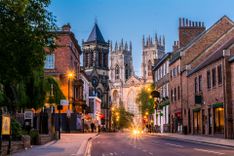Best area for the creative and free-spirited: Soho and Fitzrovia
- My recommendation: Hazlitt’s
- Location: North of Leicester Square and Chinatown, west of Covent Garden.
- Pros: Vibrant nightlife, diverse dining scene, and LGBTQ+ friendly.
- Cons: Can be noisy and crowded, especially on weekends.
Soho is very much the heart of the West End. It has long been London’s red-light district. The area is known for its narrow streets that have an unorthodox and slightly raffish air that’s unique to the city centre.
London’s artistic cliques still gather here today. The media, film and advertising industries have a strong presence, and the area’s most recent transformation has seen it become London’s most high-profile LGBTQ+ quarter, especially around Old Compton Street. It's also home to an ever-growing selection of excellent restaurants.
For a quintessentially Soho dining experience, head to Cafe Kitty. Opened in 2024, the flamboyant little restaurant is tucked away down one of Soho's historic passageways; sandwiched between a sex shop and a theatre. Once you locate Cafe Kitty's so-called 'magic' stairs, they'll lead you to a windowless restaurant decked out in lavish sofas and pink panelled walls. The delicious modern, British menu and wickedly good cocktails have won the hearts of London's fiercest food critics – and you might even spot a famous face among the diners. Cafe Kitty promises flirty fun, fantastic food and a few surprises. It's everything an evening in Soho should be.
Meanwhile Fitzrovia, the quieter Soho spillover north of Oxford Street, also has innumerable bars, cafés and restaurants.
Best hotels in this area:
- Best for a boutique stay: Mimi's Hotel Soho. This stylish boutique hotel captures the essence of Soho with its chic design, cozy rooms, and vibrant bar scene.
- Best for character and faded charm: Hazlitt’s. An early eighteenth-century building hiding romantic en-suite rooms, quirkily decorated with period furniture and old books. There’s also a small library, with a real fire, and an honesty bar.
- Best for members-club cool: Soho Suites. Located within 300 m of Carnaby Street and 400 m of Piccadilly Theatre in the centre of London.
Or browse hundreds of accommodations in the Soho and Fitzrovia area at any budget.

















